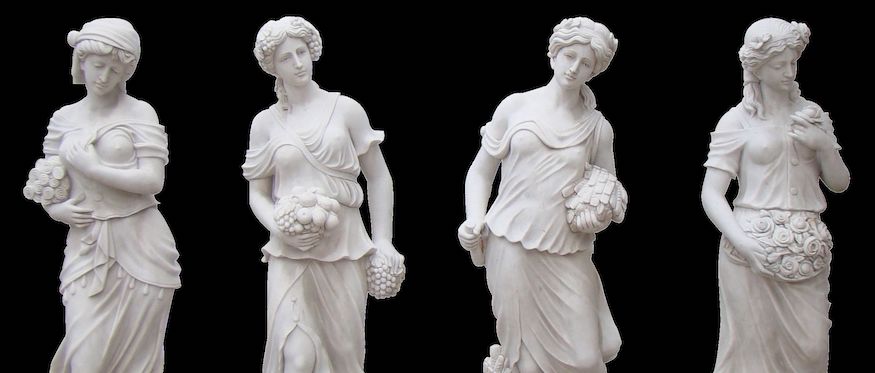Why We Need a Women’s History of the Roman Empire
Emma Southon Offers Five Myth-busting Facts About Women in Ancient Rome
There is a story from the 1970s often told by Roman historians of gender. It goes like this: students at an American college approached their male professor, a revered Roman historian, to request a course on women in Roman history. They, being among the first women ever to study ancient history at this university, wanted to see themselves on their syllabus.
Their professor disagreed. To their dismay, he replied that he may as well do a course on Roman dogs. The professor’s meaning was clear: women have no place in history. History is not about women, or children or non-binary people or indeed dogs. History, to him and to an awful lot of people, is the Doing of Important Things. It is winning battles and having Important Opinions In Public. History is politics and public deeds. Women don’t make history.
The history of the Roman Empire is usually told in this mould. It starts with Romulus, moves through Brutus overthrowing Tarquin, bounces through an appallingly tedious list of expansionist battles and generals and consuls, before emerging into the political stab-fest of the Late Republic. From there, it runs through all the emperors, occasionally mentioning a wife or mother to show how badly things can go when women take control, until Constantine invents Christianity and then Attila the Hun rolls up and ruins it.
But the history of Rome and its empire is so much more than just emperors and politicians and generals. History is so much more than Important Things. You and I, right now, are living through history. In the future, history books will be written about the times we live in, and we won’t be in them because we (mostly) do not do Important Things.
History, though, still includes us. It includes women who are not prime ministers or queens or capital-I Important. History happens to women (and men) as much as they make it.
My new book, A Rome of One’s Own: The Forgotten Women of the Roman Empire, is a revisionist history of the Roman Empire with Important Things relegated to the background. This is a history of the things the Roman male historians and biographers never wanted to write about and certainly didn’t want us to be writing about. This is a history of the things the Roman history writers designated as domestic, feminine, boring and worthless. It is a history of individuals, because, to quote Svetlana Alexievich, “this miniature expanse: one person, the individual. It’s where everything really happens.”
By focusing on women, we discover a whole new history of the Roman Empire, one where marriage is as important as war and where what it is to be Roman is constantly being reassessed.By focusing on women, we discover a whole new history of the Roman Empire, one where marriage is as important as war and where what it is to be Roman is constantly being reassessed. Including women in history forces us, as historians, to re-evaluate what a Roman was, what Romanness was, and to confront the immense scope of the Roman Empire. Including women deepens our understanding of Roman history and Roman life.
When Romulus founded Rome, he knew that his city would not be complete until it included women; the history of Rome is equally incomplete without them.
Here are five facts about Roman Women you might not know, but should:
Once you start looking for women in the Roman world, you find loads of them.
If I asked you to imagine ancient Rome, I suspect you would imagine a very masculine space. White men in white togas standing next to white columns, perhaps. Or muscle-bound gladiators beating the life out of each other in the arena. Or maybe rows of helmeted soldiers brandishing swords and shields and sandals. Women do not feature highly in most imagined versions of Rome.
In part, this is the fault of the literary sources, who wrote about men and war and politics, but it is also the fault of modern readers who have refused to look beyond those literary sources. Once we take a step outside to look at other sources, like inscriptions and archaeology and letters, or ask new questions of the histories, we suddenly find ourselves in a world full of women living lives that are full and rich and exciting.
Our eyes are opened to the fact that women are all over the damn place doing all sorts of brilliant and average things, running businesses, teaching, learning, disrupting conspiracies, being integral to state religions and anything else you can think of. The Roman empire was positively littered with average women and they deserve a look in when we imagine it.
The main women we know about are the most elite elites, and they aren’t representative.
One of the main stumbling blocks in writing or learning about Roman women from the literary sources is that they are exclusively interested in the lives of the most rarified elites. Histories were only interested in the imperial family and the senators who surrounded them. The imperial family are, by definition, weird. Their concerns are not the concerns of literally anyone else in the whole empire.
Extrapolating from the experiences of empresses like Livia and Agrippina the Younger to the experiences of Aurelia Macula, a midwife who lived in Maktar, Tunisia is as reasonable as extrapolating the experiences of Queen Victoria to me. Technically, yes, we were both English women but that is the beginning and end of what we have in common.
Senatorial women are equally removed from normal experience because being a Senator was not a job. It was an anti-job. In order to be a Senator, a man had to own over one million sesterces of property and he was not allowed to earn that. These property qualifications were checked with surprising regularity and meant that women of Senatorial rank literally had to come from generational wealth and were banned from making money by normal means not because of their gender, but because of their class.
They also had to abide by morality legislation which specifically only applied to women of Senatorial rank, which was always a small number of women. Their experiences cannot be generalized to other populations, especially to enslaved and formerly enslaved women.
The Roman empire spanned one thousand years and five million square miles, and ninety-nine percent of the women who lived and breathed and laughed and died in that empire were not imperial or senatorial women. The rules of morality, lifestyle and participation in public life that governed the one percent in Rome simply did not apply to everyone else.
Law codes don’t describe reality.
A regularly repeated fact about Roman women is that they had no legal majority; women in the Roman empire were legally children for their entire lives and could do no legal business without a male guardian. In law, this is true but it takes only the most cursory look around the empire to find exceptions which complicate the black and white law.
In the province of Arabia, for example, in the town of Mahoza near modern Baghdad, a woman named Babatha repeatedly petitioned the Roman provincial governor in Petra throughout the 120s C.E. regarding debts owed to her by her deceased husband and the guardianship of her son, Jesus. As a Jewish woman and a non-citizen, she could not represent herself in court and so she was represented by an elite Roman citizen, a woman named Julia Crispina. They later tried to sue one another for unspecified acts of violence. Women apparently appeared in court as a matter of course.
Thirty years before Babatha was born, a woman called Julia Felix died in Pompeii. At the time that Vesuvius erupted, Julia had been in the process of putting her business up for rent and had just neatly painted a To Let sign on her wall. She ran a leisure complex, containing shops, baths, hot food stalls, gardens, apartments and the closest thing the Romans had to a proper restaurant.
In her To Let sign, she is the only listed owner and no guardian or man is mentioned at all. Clearly, the idea that woman could not do legal business is less set in stone than we might want them to be. Women did act as adults and as autonomous beings all the time, all over the empire.
Roman women weren’t caged domestic animals.
The other way in which too much emphasis on aristocratic women in Roman history skews perspectives horribly is that it erases all the working women in the Roman world and from the category of woman. Aristocratic sources written by aristocratic men about the aristocracy, which includes enormous expensive epitaphs for rich women, emphasize domesticity as a woman’s only virtue.
If you only read elite sources about rich people then you get stuck with the impression that Roman women were only allowed to have children and weave wool and stare at the walls of their houses like the protagonist of The Yellow Wallpaper. This is a fiction designed by and for a class who prized domesticity as a mark of wealth and luxury because they could afford to own other women who worked for them.
Including enslaved women, freed women, Syrian women, business women, in Roman history undermines the image of ancient Rome as a homogenous, white paragon of an imagined “Western culture” and disrupts the wet dreams of fascists and racists about the European past.Shift your focus ever so slightly away from the upper classes and you’ll find women working, earning and spending money and living in the world. A terrifying number of these women were enslaved, like Deftri and Amica who drew their feet and their names on a tile that ended up on a temple in Pietrabbondante. Many were formerly enslaved women withprofessions, like Naevia Clara, an educated physician in Rome, or Hispala Faceana, a sex worker. Others were freeborn like Septimia Statonice, a shoemaker, Livinia Primagenia, a perfume-maker who died at 71 years old. All these women survive on tombstones which celebrate them for their domestic achievements.
Even elite women clearly did not really live in a separate domestic “feminine domain”. The wives, sisters and daughters of senators and emperors regularly involved themselves in the daily realities of political life. Even Turia, a profoundly conservative woman of Senatorial rank who is known only from a long epitaph from the Late Republic, is lauded by her husband for fighting several court cases, fighting off a home invasion, personally petitioning Julius Caesar and Octavian, and breaking the law to save his life.
Looking at women, and how they present themselves, humanizes history.
When we write histories of people who are not cis men, we get to rewrite history. We get to add color and humanity to stories that feel well-trodden and we get to contest old tropes. Including enslaved women, freed women, Syrian women, business women, in Roman history undermines the image of ancient Rome as a homogenous, white paragon of an imagined “Western culture” and disrupts the wet dreams of fascists and racists about the European past.
Including these women in our histories of the Roman empire reveals that it was both a multicultural, multiracial empire where women from Iraq, Albania, England and Egypt could all call themselves Roman and a brutal slave state which stole the lives of uncountable millions. Telling the stories of women across the empire reveals Roman army camps to be spaces full of families having birthday parties, and Roman cities to be centered on games where criminals were tortured and murdered for entertainment.
These stories humanize and complicate history, which is after all just stories of people in all our horrible, wonderful glory.
______________________________

A Rome of One’s Own: The Forgotten Women of the Roman Empire by Emma Southon is available via Abrams Books.




















